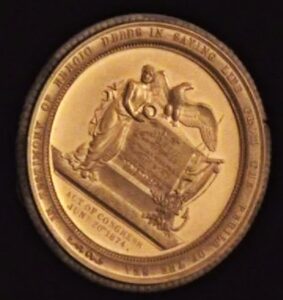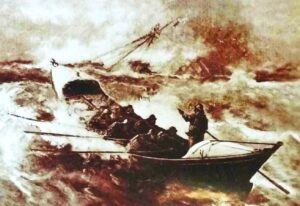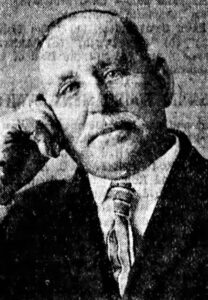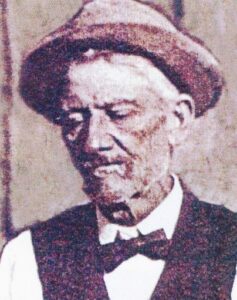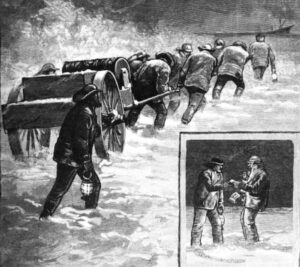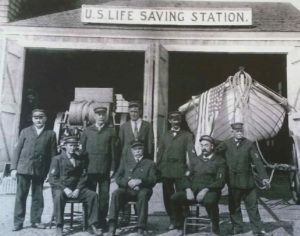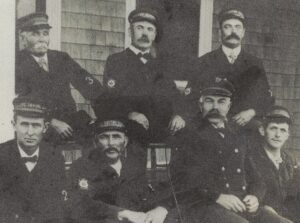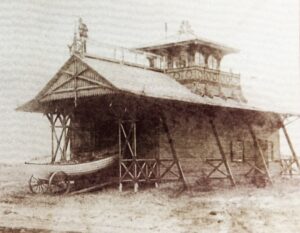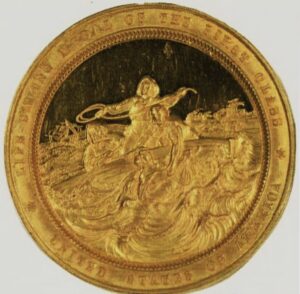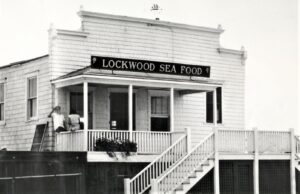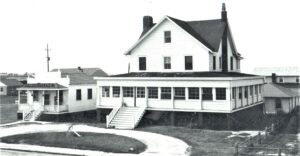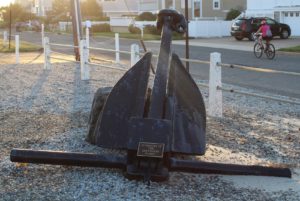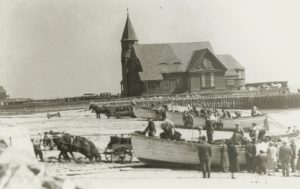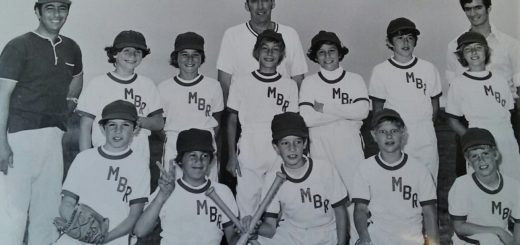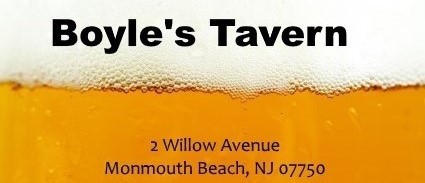Monmouth Beach — “Men of Honor”
They were a couple of rocks in the sturdy foundation of what became Monmouth Beach — Garrett White and Nelson Lockwood.
Both men exhibited astonishing bravery when called on to do so. Then they turned their attention to commerce and civics — establishing a remarkable record from which Monmouth Beach still benefits. The men put service above self — always. It’s hard to believe that neither of these courageous pioneers are remembered today. Then again, it’s hard to believe their acts of heroism too.
The two were forever linked during an epic winter storm in 1880 — part of a six-man rescue crew decorated for displaying “indomitable courage” during a double shipwreck off the Monmouth Beach coast in horrendous weather conditions. They were members of the US Life-Saving Service operating out of Station #4 in Galilee, Monmouth Beach. Later on in life both men (Nelson lived to age 75; Garrett to 80) loved to tell “tales of the sea.” When these men were born the average US life expectancy was only about age 40.
Surfman White, according to US Life-Saving Service inspector reports, in some cases literally dove into furious and freezing ocean surf — thick with an undertow and strewn with wreckage debris — to save drowning passengers or ensure a lifeline got through. The crew’s actions were a “gallant and conspicuous devotion to the service and the cause of humanity.”
“You have to go out, but nothing says you have to come back.”
—United States Life-Saving Service oath
For their bravery they were awarded Gold Medals (99.9% pure), the service’s highest honor for valor. One of America’s oldest medals, the decoration was first authorized in June 1874 by the US Congress. The lifesaving medal was designed by Anthony Paquet and was first struck at the Philadelphia Mint. In a hand-written note, US Treasury Secretary John Sherman (brother of famed Civil War General William Tecumseh Sherman) recognized the acts and awarded the medals.
Over a one-day period the life-saving crew dealt with two major shipwrecks: the E.C. Babcock (a 288-ton schooner) and the Augustina (a 300-ton brig), off Monmouth Beach during a vicious February 1880 blizzard. Also decorated were Charles H. Valentine, Benjamin Potter, William Ferguson, and John Van Brunt (Valentine was Station Keeper from 1875 to 1884).
The surfmen battled 85 mph winds, furious waves, and freezing cold. From that one storm, surfmen from Sandy Hook to Takanassee Lake were called on to rescue 5 shipwrecks over a 12-hour period. A total of 26 “Gold Medals” were awarded for that single day’s rescuing work.
In 1880 the Jersey Shore recorded 49 shipwrecks, but so skilled were the surfmen, only 2 people died. Today, the Gold Lifesaving Medal is still awarded by the US Coast Guard and remains one of the highest honors that can be bestowed on its members. More info — HERE.
Captain Nelson Lockwood
Born in New York in August 1845, as a youth Nelson worked in a brass foundry but the sea drew him to Monmouth Beach. By 1898 it appears he had left the US Life-Saving Service. He was working as an agent for Merritt-Chapman Wrecking Company, a marine salvage business. He was still active — assessing ships, passengers and cargo for loss and/or damage — when a terrible series of storms hit the NJ coast during 1913-14.
After setting up the first wireless telegraphy poles in Galilee in 1902, the Nelson Lockwood Fish Company was incorporated in 1909. It included Nelson Sr. and Jr. and Charles B. Lockwood, in the wholesale and retail fish business. Based in Galilee, family seafood operations date back to 1892. The family owned a large home and nearby a storefront for many years. The business was enduring and nearly immortal — a “Lockwood’s Sea Food” sign summits (see below) Bruce Springsteen and his E-Street Band during an album cover shoot there in Summer 1973.
Nelson Lockwood was a guy who didn’t let the big ones get away. According to the Asbury Park Press, he caught a 25-foot, 2,000-pound shark in July 1907 and he hooked an 800-pound shark in September 1910. Both off Galilee shores. As to the regular catch in those days, it was usually lots of butterfish and weakfish.
A longtime town advocate and activist, Nelson was a founding member and first president of the borough fire company in 1905. Still vital and growing, the membership marks 120 years of service in 2025. An early advocate for “teaching the kids,” Nelson was a Monmouth Beach School board member during a couple of biggies for the town — the first school in October 1909 and first graduation in June 1911. He was also elected to several terms as borough assessor.
He was a Republican candidate in the first-ever Monmouth Beach election in April 1906 but lost a close race for a seat on council. In May 1910, he was appointed president of the borough’s first board of health by his old surfman-buddy, Mayor Garrett White.
According to a December 1909 Asbury Park Press story about Galilee fishermen, Captain Lockwood was briefly profiled. Working as a “bottom fisherman” over 50 years ago, he’d become an “important factor” in the industry. Of “Nelse” Lockwood it was said, if you ever asked him for information, he never used the word “about” — instead he always gave “exact dates and figures.”
In August 1912, Lockwood said he “prizes the Gold Medal next to his wife and children and keeps it locked in a safe.” He exhibited the decoration with great pride and care during his 67th birthday celebration with family and friends in Galilee, according to a Long Branch Daily Record front-page story. Married for 50 years to Drusilla (born in Ireland in 1881, she thought herself the “first women resident of Galilee” before her June 1961 death), the couple had 8 children (one died young) — but all were born “on the ocean side.” Nelson died in August 1920 in Monmouth Beach.
* * * * *
Mayor Garrett Henry White
Born in February 1838 at Pleasure Bay, Garrett White was a remarkable fellow. Monmouth Beach was very fortunate to have him. Even more, humanity was fortunate to have him. When considering Garrett’s life’s work — whaler, surfman, mayor — one must admire the guy. His unmatched career of daring and caring should inspire others to public service.
In 1859, a young Garrett signed onto the whaling vessel “Bark Ohio” out of New Bedford, Mass and went to sea for three years (built in 1830, the 205-ton ship was lost in the Arctic Ocean in 1888). Whale-hunting was a major industry back then. Oil — the chief byproduct of whales — was then used all-over to light lamps and lubricate machinery. The whale business also advanced shipbuilding and navigation technology and fostered international trade.
Expeditions were brutally dangerous, though, lasting for several years. The larger whales — weighting over 75 tons — fought capture. White’s travels took him to the Galapagos Islands — in 1860! Early whalers ventured into treacherous and remote seas, endured poor living conditions, harsh weather and threat of shipwreck (no wonder White admitted to reading the Bible every day). By the 1870s most of the whale stocks in the Atlantic had been depleted and the industry became unprofitable. White also worked with pound fishing boats in his time in town.
After his life-saving career which started in 1862, White threw himself into the “new Monmouth Beach” — pulling off a neat twofer the year the borough was incorporated. In 1906 he was a founding member of the first school board of education and a founding member of the first borough council. He out-polled all other candidates in the borough’s first ever municipal election. At the borough’s first-ever organizational meeting in April 1906, White prayed for “divine guidance.” All Monmouth Beach homeowners today know that one has been largely answered.
At age 71, White became the second mayor of Monmouth Beach, serving briefly for two years from 1909-1910. The borough’s first dog registration ordinance was passed during his mayoralty as the summer of 1909 was beginning. A annual dog tag cost $1 the town’s first “dog-catcher” when on the payroll.
Upon his death in January 1919, Garrett left a lot to live up to. And incredibly enough, his family legacy is just as rich and impressive. He was great grandfather to G. Henry Mihm, who was a longtime commissioner and also a borough mayor (1945-1949) and started development of the town’s marina area. He was the great, great grandfather of Walter Mihm, who made the borough’s riverfront area into a multi-million-dollar marine business — still very much in operation today. Those two guys merit their own story as well — HERE.
No doubt I missed something on these two amazing men or got it wrong? Others with more or better info are welcome to reach out — HERE.
More Info:
• America’s Storm Warriors: Galilee Chapter — HERE
• “Galilee” of Monmouth Beach Images — HERE
• Galilee Fishermen: “Harvesting the Sea” — HERE
• US Life-Saving Service at Takanassee Lake — HERE
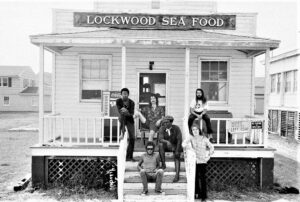
Galilee Groovin’ — Bruce Springsteen and the E-Street Band hang out at Lockwood’s Sea Food market on Ocean Avenue, August 1973. The Boss sits in front. In the photo behind Bruce ( l to r) are: David Sancious, Vini Lopez, Clarence Clemons, Garry Tallent, and Danny Federici. It was a cover shot possibility for his The Wild, the Innocent & the E Street Shuffle album released in November 1973. All in Galilee — mere steps from an ocean and a river.
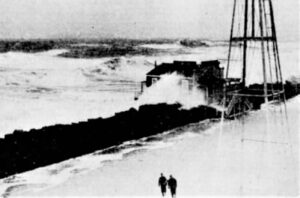
Lockwood’s Sea Food market on the seawall along Ocean Avenue is hit by “mountainous seas,” November 1935.
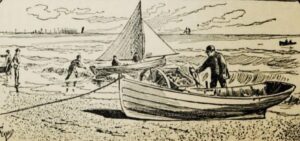
Galilee fishermen, 1880s. In Galilee one has “the ocean for a front yard and the river for a back yard,” —Long Branch Daily Record, 1964.
